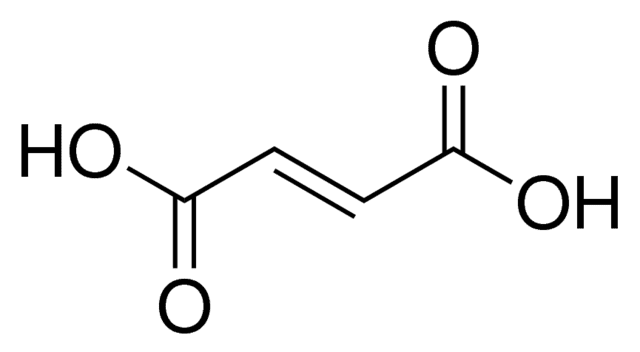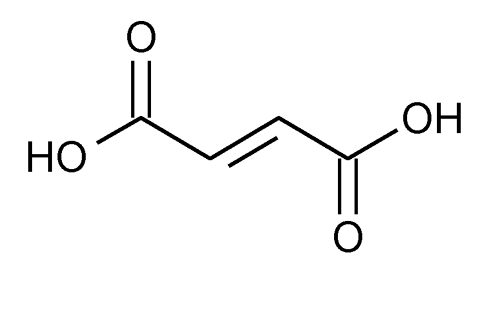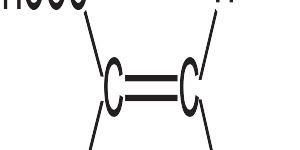Formula C4H4O4 Melting point 287 °C Density 1.64 g/cm³ Appearance White solid | Molar mass 116.07 g/mol IUPAC ID (E)-Butenedioic acid Soluble in Water | |
 | ||
Related compounds | ||
Fumaric acid meaning
Fumaric acid or trans-butenedioic acid is the chemical compound with the formula HO2CCH=CHCO2H. This white crystalline compound is one of two isomeric unsaturated dicarboxylic acids, the other being maleic acid. In fumaric acid the carboxylic acid groups are trans (E) and in maleic acid they are cis (Z). Fumaric acid has a fruit-like taste.
Contents
- Fumaric acid meaning
- Chemistry
- Biology
- Food
- Medicine
- Psoriasis
- Other uses
- Safety
- Interactive pathway map
- References

The salts and esters are known as fumarates. Fumarate can also refer to the C4H2O4−− ion (in solution).
Chemistry

Fumaric acid was first prepared from succinic acid. A traditional synthesis involves oxidation of furfural (from the processing of maize) using chlorate in the presence of a vanadium-based catalyst. Currently, industrial synthesis of fumaric acid is mostly based on catalytic isomerisation of maleic acid in aqueous solutions at low pH. Maleic acid is accessible in large volumes as a hydrolysis product of maleic anhydride, produced by catalytic oxidation of benzene or butane.

The chemical properties of fumaric acid can be anticipated from its component functional groups. This weak acid forms a diester, it undergoes additions across the double bond, and it is an excellent dienophile.

Fumaric acid does not combust in a bomb calorimeter under conditions where maleic acid deflagrates smoothly. For teaching experiments designed to measure the difference in energy between the cis- and trans- isomers, a measured quantity of carbon can be ground with the subject compound and the enthalpy of combustion computed by difference.
Biology

Fumaric acid is found in fumitory (Fumaria officinalis), bolete mushrooms (specifically Boletus fomentarius var. pseudo-igniarius), lichen, and Iceland moss.
Fumarate is an intermediate in the citric acid cycle used by cells to produce energy in the form of adenosine triphosphate (ATP) from food. It is formed by the oxidation of succinate by the enzyme succinate dehydrogenase. Fumarate is then converted by the enzyme fumarase to malate. Human skin naturally produces fumaric acid when exposed to sunlight.
Fumarate is also a product of the urea cycle.
Food
Fumaric acid has been used as a food acidulant since 1946. It is approved for use as a food additive in the EU, USA and Australia and New Zealand. As a food additive, it is used as an acidity regulator and can be denoted by the E number E297. It is generally used in beverages and baking powders for which requirements are placed on purity. It is generally used as a substitute for tartaric acid and occasionally in place of citric acid, at a rate of 1 g of fumaric acid to every ~1.5 g of citric acid, in order to add sourness, similarly to the way malic acid is used. As well as being a component of some artificial vinegar flavors, such as "Salt and Vinegar" flavored potato chips, it is also used as a coagulant in stovetop pudding mixes.
Medicine
In patients with relapsing-remitting multiple sclerosis, the ester dimethyl fumarate (BG-12, Biogen) significantly reduced relapse and disability progression in a phase 3 trial. It activates the Nrf2 antioxidant response pathway, the primary cellular defense against the cytotoxic effects of oxidative stress.
Psoriasis
Various Fumaric acid esters (FAES) have specific immunomodulating (respectively moderate immunosuppression) properties which are responsible for certain effects in the treatment of psoriasis. In the Netherlands, Germany, Austria and the Benelux countries substances derived from fumaric acid have been used for half a century for this purpose. Although it seems that a certain effectiveness exists (and many studies have confirmed the effect), more statistically powerful studies are necessary to provide better evidence of the effectiveness of fumaric acid esters in treatment of psoriasis (e.g. more accurate in terms of the dermatological nosology of this autoimmune disease). Such studies should in the future help specify which psoriasis variants (in terms of the course, the immunological profile of the patient etc.) are suited to be treated with fumaric acid esters.
Fumaric acid is naturally present in the herb called Fumaria officinalis. The top of this herb is used to treat various skin disorders including psoriasis. Baths with this herb have been used for several centuries. At present, these baths (after consultation with a general practitioner or dermatologist) are used as an adjunct therapy to basic treatment.
Other uses
Fumaric acid is used in the manufacture of polyester resins and polyhydric alcohols and as a mordant for dyes. Since the early 21st century, it has been used to synthesize one of the first metal-organic frameworks presenting commercial applications thanks to its remarkable adsorption and mechanical properties, combined with a low toxicity compared to other well-studied MOFs.
Safety
Fumaric acid converts to the irritant maleic anhydride, upon partial combustion.
It is "practically non-toxic" but high doses are probably nephrotoxic after long-term use.
Interactive pathway map
Click on genes, proteins and metabolites below to link to respective articles.
